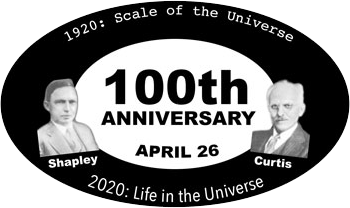Centennial of the Great Debate: From "Scale of the Universe" to "Life in the Universe"
Robert Nemiroff, Michigan Technological University
Jerry Bonnell, CRESST, University of Maryland & NASA Goddard Space Flight Center
Humanity’s place in the universe was debated 100 years ago in a famous argument between two eminent astronomers of the 1920s. In what is now called the Great Debate, Heber Curtis and Harlow Shapley gave evidence for different views about whether our Sun is in the center of the Milky Way Galaxy, and, more famously, whether other galaxies exist outside of our own. The Shapley-Curtis Great Debate was held on 26 April 1920 at the Smithsonian Institution's Museum of Natural History in Washington, DC.
 In commemoration of this centennial, we invited a series of articles, videos, and commentaries and posted them online on 26 April 2020 at NASA, through our Astronomy Picture of the Day (APOD) website, and at Michigan Technological University. In addition to reviewing the 1920 debate, including commentaries from living descendants of the 1920 debaters, a new debate is framed on a topic that currently divides the astronomical community: How, if ever, will extraterrestrial life be discovered? The 1920 Great Debate is referred to as the "Scale of the Universe" debate; we're calling the centennial event the "Life in the Universe" debate.
In commemoration of this centennial, we invited a series of articles, videos, and commentaries and posted them online on 26 April 2020 at NASA, through our Astronomy Picture of the Day (APOD) website, and at Michigan Technological University. In addition to reviewing the 1920 debate, including commentaries from living descendants of the 1920 debaters, a new debate is framed on a topic that currently divides the astronomical community: How, if ever, will extraterrestrial life be discovered? The 1920 Great Debate is referred to as the "Scale of the Universe" debate; we're calling the centennial event the "Life in the Universe" debate.
In the new debate, more than a dozen noted thinkers across astronomy and astrobiology give their best guesses about how extraterrestrial life might be discovered. Presenters include the following:
- Guy Consolmagno, Director, Vatican Observatory
- Sabine Hossenfelder, Research Fellow, Frankfurt Institute for Advanced Studies
- John Mather, Senior Astrophysicist, NASA Goddard Space Flight Center
- Caleb Scharf, Director of Astrobiology, Columbia University
- Sara Seager, Professor of Planetary Science, MIT
- Jill Tarter, Chair Emeritus for SETI Research, SETI Institute
These and other presenters raise a host of possibilities, including biological evidence found on planets, moons, or asteroids right here in our solar system; biological evidence found by large telescopes inspecting planets orbiting distant stars; and signs or signals of high technology indicative of extraterrestrial intelligence.
We now know that Shapley was right: our Sun is not in the center of our Milky Way Galaxy, and that Curtis was also right: many galaxies do exist outside of our own. The resolution of the 1920 Great Debate led to the discovery of the vast majority of our universe and humanity’s place in the universe physically. How the 2020 debate will be resolved is not yet known, but several prominent astronomers feel a resolution will come in the next 20 years, a time when humanity learns its place in the universe biologically.
We invite AAS members interested in volunteering their own reasoned opinions to our "Life in the Universe" debate to contact either or both of us: Robert Nemiroff (Michigan Technological University) and/or Jerry Bonnell (CRESST, University of Maryland & NASA Goddard Space Flight Center). We gratefully acknowledge support for this project from NASA and Michigan Technological University.

